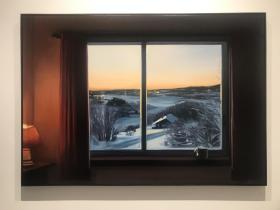Imants Tillers was shocked when he saw Notre Dame ablaze. Not long after the Paris cathedral collapsed, there were flames outside his home in Cooma and a virus lilting across the breezeway of our times. His response to these three events infuses this exhibition with anger, energy and mystic Sufi-styled questions, like ‘when will we be safe?’ As Soon As Tomorrow suggests that questions such as this are unanswerable, since tomorrow will be exactly the same.
Like so many artists, the Black Summer fires presented the challenge of evacuating a lifetime of work. Lucy Culliton who also lives on the Monaro plains had already summoned the removalists, and Bundanon down the coast had too – sending away the Nolans, the Blackmans and the Boyds – 3,800 works, many of which were painted en plein air in their bushland settings. But where do our artists send their work when the landscape is alight?
Apocalypse, 2021 combines filmic reference to Kubrick with Giorgio de Chirico’s view of Notre Dame, unburned, rendered in Tillers’ characteristic style of blending and lending, painting on numbered canvas boards.
In 1976, Colin McMahon created Scared, and in 1989, Tillers painted Untitled (scared), later adapting his bleak, flat blacks in response to the AIDS crisis, and now to COVID-19. The oppression this work represents has become Contagion, in response to the way the pandemic rapidly blurred one crisis with the next.
Three works reinterpret Arthur Streeton’s landscapes, incorporating references to Bobby West Tjupurrula and Robert Rauchenberg, while Terra nullius fills the Monaro firegrounds with ignition points, swirling around a box of red head matches, and the urgent call to ‘flee, yes flee’. A declaration ‘we have decided not to die’, claims the bottom right hand corner like a moral compass, balancing the feng-shui of surviving the Anthropocene. It calls down the good chi in hope of a more productive cycle of life.
This work encapsulates the themes of the exhibition, where it is not just people who are frightened. In his signature style, the text that draws the work together states that life itself is frightened – it is ‘burning’, it is ‘broken’, it is ‘terrified’.
But before the healing, the viewer must face the fact that things are ‘cut’ and ‘broken’. At the centre of this narrative sits the artist’s home, Blairgowrie, which may well have gone up in smoke along with 18,636,079 hectares of Australia.
Read: Opera review: Platée, Pinchgut Opera
The artist’s classical references extend a ladder to another realm. From this vantage, the viewer is invited to unfold what is hinted and suggested, more than fully drawn. The bible is quoted, and in his characteristic eclecticism, Buddha is too. But so is the arrogance of Captain Cook – particularly, Cook’s decision to overlook the people of Australia, whom his English gaze apparently could not see. This is unfortunate, since back then, fires tended to be better managed.
Tillers’ Latvian background connects him to the pain of being silenced by ruling powers of otherness. It lends him a unique perspective from which to reflect on the complexity of Australia – from flood to fire, plagues or droughts – and the worst transgressions of old.
Clive Hamilton and Monaro regenerative farmer Charles Massy align this exhibition with their own concerns, bonding Tillers’ work with contemporary dialogues in science and agriculture. Embedded is the message: be warned, time is running out.
As a man displaced in the diaspora, Tillers’ assessment of the complex and unanswerable resonates more today than ever.
Imants Tillers: As Soon as Tomorrow
Roslyn Oxley9 Gallery, Sydney
8 Soudan Ln, Paddington
Free entry
Imants Tillers is on display until 17 December 2021





